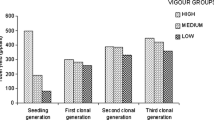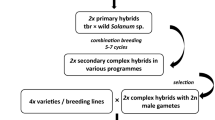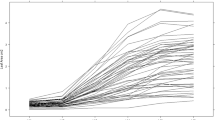Summary
An incomplete diallel cross was used to study components of genetic variation in potatoes for a range of characters after early and late harvest. The progenies were also used to evaluate five predictors of progeny performance, namely the mean seedling performance, the mid-parent value and the means of the selfed progenies, of the diploid progenies and of the test-cross progenies. For almost all characters, the general combining ability effects were predominant, although the specific combining ability effects present were greater at late than at early harvests. The seedling performance for tuber yield, number of tubers and average tuber weight did not show any relevant relationship to the field performance. The midparent value provided, in general, satisfactory predictions of the mean progeny performance obtained in the diallel, except for ware tuber yield. The selfed and the diploid progenies did not improve the prediction of progeny means compared to the mid-parent value. The predictions based on the test-crosses surpassed those of the mid-parent value, particularly for tuber yield at ware potato harvest. Methods to identify superior parents are discussed.
Similar content being viewed by others
References
Brown J, Caligari PDS (1989) Cross prediction in a potato breeding programme by evaluation of parental material. Theor Appl Genet 77:246–252
Caligari PDS, Powell W, Liddell K, Maine MJ De, Swan GEL (1988) Methods and strategies for detectingSolanum tuberosum dihaploids in interspecific crosses withS. phureja. Ann Appl Biol 112:323–328
Comstock RE, Robinson HF (1952) Estimation of average dominance of genes. In: Gowen JW (ed) Heterosis, Iowa State Univ Press, Des Moines, Iowa, pp 494–516
Feistritzer W (1952) Die Selbstungsanalyse, eine Voraussetzung fur die Kreuzungszucht der Kartoffel. Z Pflanzenzucht 31:173–195
Griffing B (1956) Concept of general and specific combining ability in relation to diallel crossing systems. Aust J Biol Sci 9:463–493
Hermsen JGT, Verdenius J (1973) Selection fromSolanum tuberosum group Phureja of genotypes combining high frequency haploid induction with homozygosity for embryo spot. Euphytica 22:244–259
Hougas RW, Peloquin SJ (1958) The potential of potato haploids in breeding and genetic research. Am Potato J 35:701–707
Iwanaga M (1984). Discovery of a synaptic mutant in potato haploids and its usefulness for potato breeding. Theor Appl Genet 68:87–93
Kempthorne O (1957) An introduction to genetic statistics. John Wiley and Sons, New York, pp 96–98
Keuls M, Garretsen F (1977) A general method for the analysis of genetic variation in complete and incomplete diallels and Noth Carolina II (NCII) designs. Part I: procedures and general formulas for the random model. Euphytica 26:537–551
Killick RJ (1977) Genetic analysis of several traits in potatoes by means of a diallel cross. Ann Appl Biol 86:279–289
Maris B (1973) Studies with potato diploids on the inheritance of resistance to wart diseases. Potato Res 16:324
Maris B (1988) Correlations within and between characters between and within generations as a measure for the early generation selection in potato breeding. Euphytica 37:205–224
Maris B (1989) Analysis of an incomplete diallel cross among three ssp.tuberosum varieties and seven long-day adapted ssp.andignea clones of the potato (Solarium tuberosum L.). Euphytica 41:163–182
Matsubayashi M (1979) Genetic variation in dihaploid potato clones, with special reference to phenotypic segregation in some characters. Sci Rep Fac Agric Kobe Univ 13:185–192
Neele AEF (1990) Study on the inheritance of potato tuber yield by means of harvest index components and its consequences for choice of parental material. Euphytica 48:159–166
Neele AEF, Louwes KM (1986) The analytic breeding method: possibilities for potato breeding. In: Beekman AGB, Louwes KM, Dellaert LMW, Neele AEF (eds) Potato research of tomorrow. Pudoc, Wageningen, pp 107–114
Neele AEF, Louwes KM (1989). Early selection for chip quality and dry matter content in potato seedling populations in greenhouse or screenhouse. Potato Res 32:293–300
Tai GCC (1976). Estimation of general and specific combining abilities in potato. Can J Genet Cytol 18:463–470
Author information
Authors and Affiliations
Additional information
Communicated by A. R. Hallauer
Rights and permissions
About this article
Cite this article
Neele, A.E.F., Nab, H.J. & Louwes, K.M. Identification of superior parents in a potato breeding programme. Theoret. Appl. Genetics 82, 264–272 (1991). https://doi.org/10.1007/BF02190611
Received:
Accepted:
Issue Date:
DOI: https://doi.org/10.1007/BF02190611




